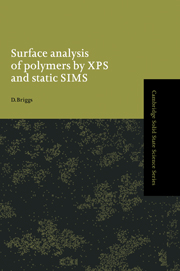Chapter 6 - Polymer surface analysis case studies
Published online by Cambridge University Press: 08 October 2009
Summary
Introduction
Chapters 3 and 5 describe the information levels of XPS and SSIMS, respectively. The two techniques are highly complementary, having certain shared attributes but differing markedly in other aspects. XPS detects all elements except hydrogen, is inherently quantitative but has limited sensitivity (typically 0.2 atomic % detection limit for low photoelectron cross-section elements) whereas SSIMS detects all elements with isotope specificity (but some, notably nitrogen, only in combined ions), is inherently difficult to quantify but can have very high sensitivity (ppm of one monolayer). Structural information in XPS is dominated by functionality and limited by the poor dynamic range of chemical shifts whereas SSIMS has a high level of molecular specificity and can discriminate molecular from macromolecular entities. XPS typically has a sampling depth of ∼5nm but in certain circumstances this can be varied and reduced to ∼1 nm. The SSIMS sampling depth is essentially fixed and corresponds to the outermost monolayer. Both techniques are capable of analysing small areas of the order of 50 μm width/diameter and of imaging with reasonable spatial resolution (XPS ~ 10 μm, SSIMS ~ 1 μm under typical conditions). From this it is clear, even in principle, that combining information from the two techniques will be beneficial.
In the early days of SSIMS, when the instrumentation was based on compact quadrupole mass spectrometers, combination XPS/SSIMS systems were popular. Both techniques could be used to examine a sample sequentially in a costeffective way (only one vacuum system is needed and there are no uncertainties about comparing information from discrete samples). As the instrumentation has evolved in complexity (especially with ToF SIMS) stand-alone systems have become the norm.
- Type
- Chapter
- Information
- Surface Analysis of Polymers by XPS and Static SIMS , pp. 156 - 189Publisher: Cambridge University PressPrint publication year: 1998
- 2
- Cited by



